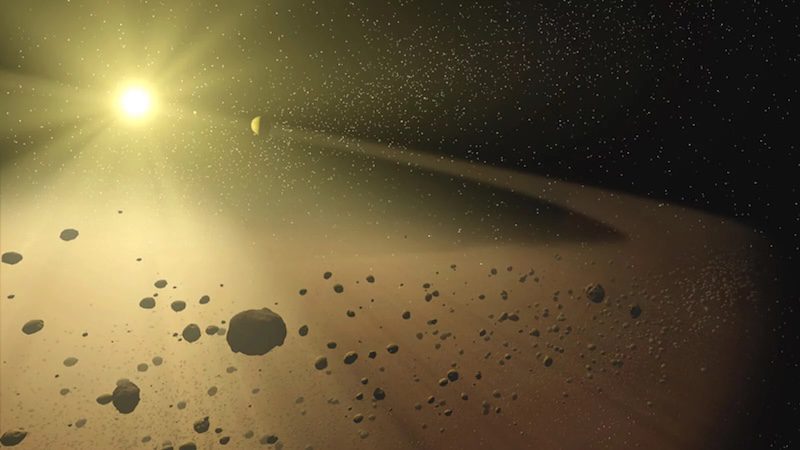Millions of new solar system objects have just been discovered, and for the first time, we’re seeing them in technicolor. Thanks to the groundbreaking work of the Vera C. Rubin Observatory and its Legacy Survey of Space and Time (LSST), scientists have mapped an enormous collection of small solar system objects, like asteroids and comets, minor planets, and more. This discovery isn’t just big; it’s historic. Using advanced imaging and multi-color astronomical filters, we can now study space like never before. These vibrant views will help us better understand the structure, history, and evolution of our solar system, revealing secrets hidden in darkness for billions of years. It’s a cosmic breakthrough in full color.
This video depicts a simulation of millions of small solar system objects that astronomers said the Vera C. Rubin Observatory will discover in the next 10 years. Video via Jake Andrew Kurlander/ YouTube.
The Next Frontier: Surveying the Sky in Unprecedented Detail
The Vera C. Rubin Observatory leads a revolution in space observation technology. Its 10-year observational survey called the Legacy Survey of Space and Time (LSST) will scan the sky repeatedly, mapping billions of stars and countless solar system small body populations. This survey is much faster and deeper than any before. It uses a digital camera with 3.2 billion pixels, allowing astronomers to track objects moving across the sky with great accuracy.
The observatory will spot not only distant stars but also near-Earth objects (NEOs) and main-belt asteroids. By covering large areas quickly, it will discover millions of new solar system objects previously hidden. The data will help scientists understand how these bodies move and change over time. This unprecedented detail in the solar system discovery process will improve our knowledge of the cosmos dramatically.
A Technicolor View of the Cosmos
Seeing the universe in color opens new doors. Past astronomical surveys mostly captured one-color images. This made it hard to tell what things were made of or how they might behave. The Rubin Observatory uses multi-color astronomical filters to record images in several colors, revealing details about the surfaces and materials of asteroids and comets.
This new approach lets astronomers measure the light reflected by objects at different wavelengths. For example, colors can show if an asteroid contains ice, rock, or metals. The technicolor view gives a clearer picture of the solar system formation process and helps identify objects’ origins. The combination of colors, speed, and size helps map these objects more precisely than ever before.
Mapping Millions of Asteroids, Comets, and Minor Planets
The Rubin Observatory will discover vast numbers of small solar system bodies. Experts expect to find over 127,000 near-Earth objects detected, about 5 million main-belt asteroids identified, 109,000 Jupiter Trojans discovered, 37,000 trans-Neptunian objects found, and between 1,500-2,000 Centaurs observed. These objects orbit the Sun but differ widely in size, location, and composition.
| Object Type | Expected Number Discovered |
|---|---|
| Near-Earth Objects (NEOs) | 127,000 |
| Main-Belt Asteroids | 5 million |
| Jupiter Trojans | 109,000 |
| Trans-Neptunian Objects | 37,000 |
| Centaurs | 1,500-2,000 |
The survey will collect detailed data on each object’s color, brightness, and motion. This will help build the most complete catalog of minor planets and comets ever created. These discoveries will improve our understanding of planetary orbits and the overall layout of the solar system.
Small Solar System Objects — Why They Matter
Many people overlook small solar system objects like asteroids and comets. But these bodies hold keys to our past. They act as time capsules from the early days of the solar system. Their composition reveals clues about how planets formed and evolved over billions of years. Studying these objects helps scientists learn more about solar system formation.
Besides history, these objects matter because some pose risks to Earth. Tracking hazardous asteroids is essential for planetary defense. Identifying potential threats early can give us time for potential asteroid deflection. The Rubin Observatory’s work will improve early detection, making Earth safer from cosmic dangers.

Simulating the Solar System with Advanced Software
To make sense of the flood of new data, astronomers use open-source simulation software called Sorcha simulation software. This tool helps model the complex movements and locations of the solar system’s small body populations. It corrects for observation biases using debiasing observational patterns so that scientists get accurate counts and characteristics of objects.
Sorcha simulation software lets researchers predict what the Rubin Observatory might see before the data arrives. This improves planning and interpretation. By simulating millions of objects’ orbits, colors, and sizes, scientists can refine models of the solar system’s evolution and test theories against real observations.
Related Article How SpaceX’s Starship Could Reach Mars in Just Three Months
Deneb The Bright, Distant Star –Facts, Features

